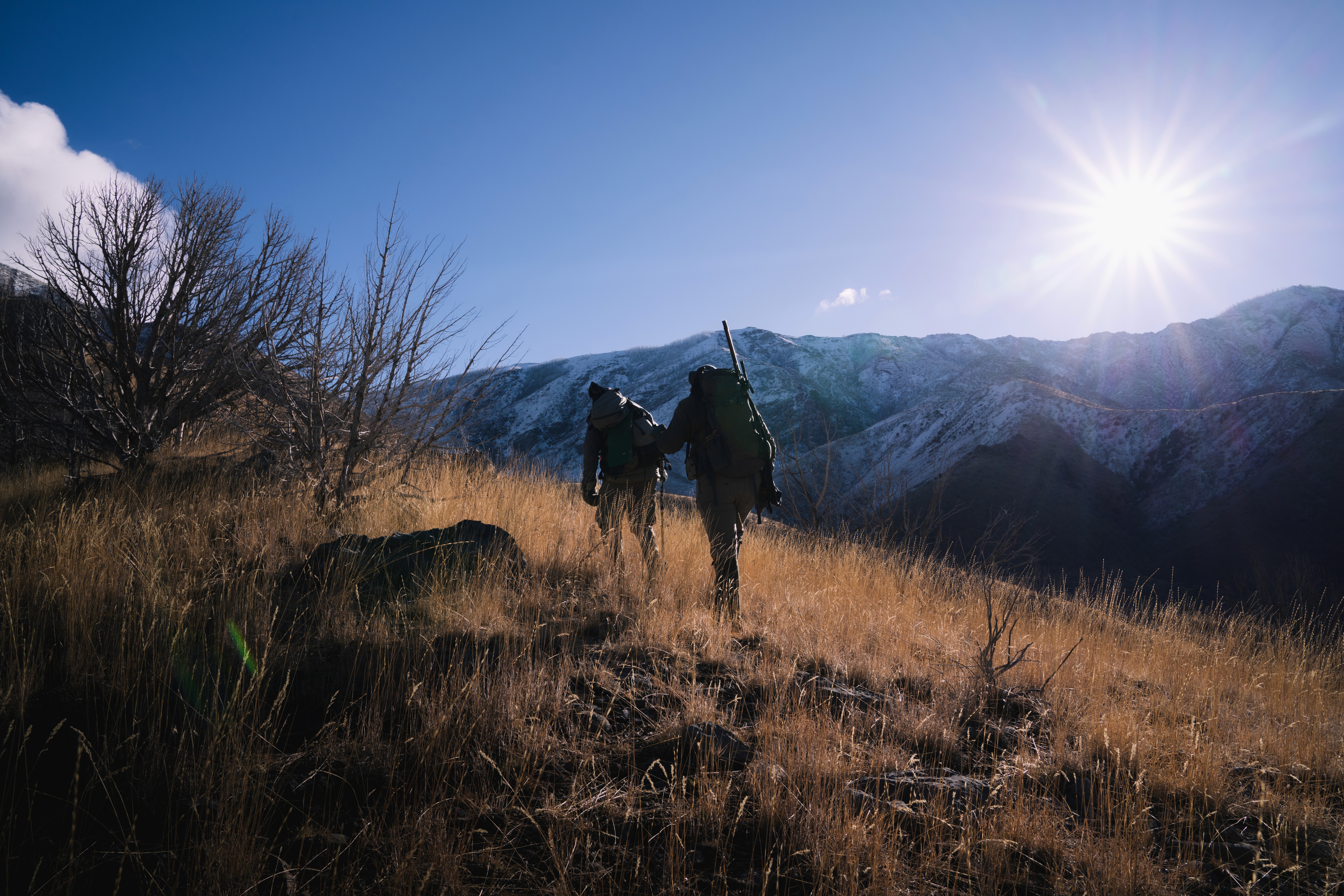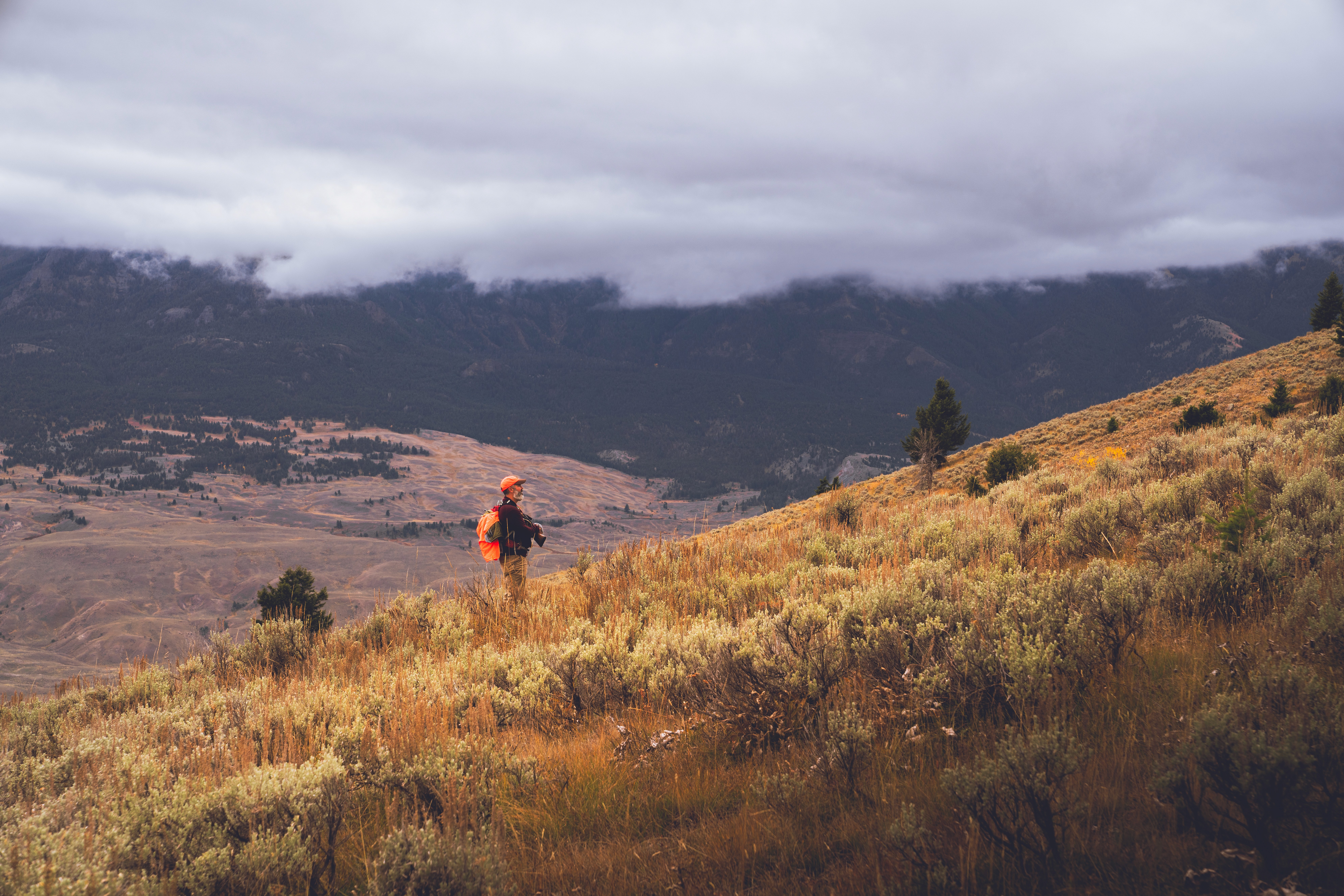



Whitetail Hunting
Whitetail Hunting Fitness for the Appalachians
This is our first article in the Packmule Training Journal since evolving from Human Predator Packmule to Packmule Training Co. In honor of all that, I’m taking it back to the motherland to talk fitness for whitetail hunting in the Appalachian mountains.
I grew up hunting whitetails in Central Pennsylvania. And like the rest of the Appalachians, the mountains there have steep ridges, rocky terrain mixed with forest, and uneven hollows between fingers leading up to hardwood flats. You can’t hunt these mountains well without the strength, endurance, and mobility to handle the terrain. That’s especially true with mobile whitetail hunting’s surge in popularity, the rebirth of deer tracking, and, my personal favorite, still hunting. Hell, you need solid fitness just to get your tree stand into a good spot away from other hunters for an all day sit.
Appalachian hunting fitness can’t haphazardly be approached. Whitetail hunters need structured training if they hope to be fit enough to give themselves a solid shot at success — and enjoy themselves while they hunt. Getting to the gym is a good start, but you need to do the specific exercises and methods that carry over to moving through Appalachian terrain.
Smart Hunting Workouts: Training With Purpose
“Smart” means a few things when it comes to training with hunting mountain whitetails in mind. First, it means organizing your training so that you get something out of it. I’ll help you do that right now by making a declaration: You’re an athlete. You have to be to effectively tromp through mountains after whitetails. Since you’re an athlete, you have to train like one.
That means bodybuilding-style bodypart training splits won’t get it done for you. They’ll make your muscles bigger and a little stronger, that is true. But they won’t prepare you to move in the mountains, and they don’t fit into a hunting workout plan. Training that way is like buying a Ferrari with a Volkswagen engine. It’ll look nice, but it sure as hell won’t perform how you want — especially in the mountains. That’s because the hyperfocus on muscle growth at the expense of everything else often causes stiffness that promotes poor movement. Your joints move worse, causing you to move worse. Forget about muscle, think about movement.
Once you make that mindset shift, you can work on the second part of the equation — doing the specific strength exercises that help you move uphill, downhill, and sidehill. Let’s have a look at some example exercises and what they’ll do for you.
Uphill drive: front squats (normal tempo), rear-foot elevated split squats, step-ups, reverse lunges, single-leg RDLs, stability ball hamstring curls, calf raises (normal tempo)
Downhill control: front squats (lowering emphasis), step-downs, single-leg goblet squat to box, calf raises (lowering emphasis)
Sidehill control: single-leg RDLs, ankle mobility drills, side step-ups, and step-downs
Functional strength for hunters looks like traditional strength training organized in a smart way to build general strength while including the movements that prepare you for Appalachian terrain. It also includes exercises such as carries, sled drags, and regular upper-body strength training to prepare you for moving your gear, and, hopefully, a nice buck around the mountain.
There’s another specialized strength/conditioning hybrid exercise that prepares you for mountainous terrain — rucking.
Ruck Training for Hunters: Building Your Appalachian Engine
Let’s say you’re a mobile whitetail hunter. You’re pushing back in relatively far and relatively light. That said, you still have to get all of your gear deep into the woods. Then, if all goes well, you have to get a buck, and all of your gear, back out of the woods. Training your body to move efficiently under load is of huge benefit — and rucking gives you that benefit.
Now, ruck training for hunters needs to follow a progression for it to be most effective. If you’ve never rucked before, start on flat ground with about 15% of your body weight in your pack. Move at a pace that keeps your heart rate in Zones 1 and 2. You’ll need to go for at least 30 minutes to start getting the benefits, eventually working the time up to hours as needed. Progress up to an hour or more with 15% of your body weight before adding more weight to your pack. Once you can do that, bump the weight up to 20% of your body weight. That’s where you’ll mostly live with your weighted pack training.
After a few months of accruing a couple of hours per week on flat ground, get on terrain with your ruck. Drop the weight back down to 15% of your body weight as you get started on terrain, and move at a steady and sustainable pace. You’ll likely get out of Zone 2, but that’s okay, so long as you’re not skyrocketing your heart rate and your average heart rate for the workout remains in Zone 2. As you’re able to move faster while keeping your heart rate down, bump the weight back up to 20%.
Another thing about getting on terrain with your ruck — don’t start with the gnarliest shit available. Start on gradual, rolling terrain and progress up to the nasty stuff. Drop the weight back down each time you increase the difficulty of the terrain, and progress back up as you are able to move faster while keeping your heart rate down.
I said “move faster” but this isn’t a race. What I mean is that you’ll notice you’re able to maintain the same, or slightly faster, pace at a lower heart rate. This means that your efficiency under load and your aerobic conditioning is improving. I’m not telling you to consciously move faster. I just want you to notice your heart rate staying down as you ruck.
It’s important to take good care of your ankles and feet as you ruck — especially as you work your way onto terrain. It ain’t if you roll your ankle, it’s when. Improving your ankle mobility reduces the likelihood that an ankle roll causes an injury. You should be working on your ankle mobility every day, regardless of whether or not you’re rucking. But it becomes even more important as you ruck.
Hunters Need Structured Training: Avoiding Randomness
Hunters needing structured training seems to be a surprise to some folks — but it shouldn’t be. Random training produces random results. Structured training produces predictable and sustainable results.
Remember when I said you’re an athlete? Well, smart athletes follow structured training. Think of what you do as strength and conditioning for hunters, not just working out. That mindset will do you a lot of good. Once you have that locked in, it’s time to understand that all of your training — strength, conditioning — must fit together, and each must progress towards your in-season hunting demands. It begins with early offseason training, progresses to pre-season hunting training, and eventually moves into in-season training. Below is an example of what that looks like in our system, based on the physical abilities we work on during each part of the training year.
Early Offseason: aerobic capacity + strength endurance
Late Offseason: max strength + aerobic power
Pre-season: specific mountain conditioning + specific mountain strength endurance
In-season: general strength training + aerobic conditioning maintenance
Following this kind of structured, year-round progression instead of randomly throwing workouts together gives you the best opportunity to build a body that’s ready for Appalachian terrain. It works because it layers important mountain fitness components on top of each other. You need aerobic capacity before you build aerobic power — and each helps get your ass up the hill. Strength endurance before max strength helps you get the most out of each while also preparing you for the specific strength work done during the pre-season. All of the offseason work prepares you to get the most out of your specific pre-season work, which peaks you for hunting season. The in-season work keeps you healthy while you hunt.
The Appalachian Factor: Training for Steep Country
The Rockies, the Sierras, the Cascades — they get all the love and respect. Sure, they deserve it. But anyone who’s seriously hunted the Appalachians will tell you that they ain’t no joke. While they may not have the altitude of the younger mountain chains, they can be just as steep and just as rocky. You have to prepare for the uphills and downhills — that’s the crux of Appalachian hunting fitness.
Uphill training for hunters is about creating drive and pull. We train quads to drive you up the hill; we train the hamstrings to pull you up the hill. And we do that with specific strength exercises like those listed above — step-ups, rear-foot elevated split squats, etc. As we build strength, we also build uphill endurance by improving our aerobic capacity and aerobic power, eventually doing that specifically on mountain terrain.
Downhill training for hunters is all about control. We train the quads and hamstrings to handle the stress of controlling your body weight as you move downhill; we train joint mobility and balance so that you stay in a good position instead of going ass over tin cups down the mountain. This is where exercises that focus on the lowering portion of the movement come in handy — single-leg goblet squats to box, step downs, etc.
It’s important to work on all of this year-round to some degree, but it truly culminates in your pre-season training. That’s when the specific strength exercises we discussed above are most impactful. We use general training during the early and late offseason to build raw materials. We put those raw materials specifically to work during the pre-season so that you’re fully prepared for Appalachian terrain in season.
The big takeaway here is that your pre-season strength and conditioning must be specific to have you fully prepared for steep uphills and downhills — especially if you’re making your way out of the mountains with a buck on your back.
Longevity and Year-Round Readiness
If you’re anything like me and our Backcountry Ready members, you want to head to the mountains for the rest of your life. You ain’t doing that without training in a way that promotes longevity. That means you need to do year-round, sustainable training. Yes, you’ll improve your fitness for hunting whitetails in the Appalachians. But you’ll also improve your recovery and increase the likelihood of a longer hunting career.
Longevity for hunters looks like the training structure we outlined above. You build your aerobic base with aerobic capacity training and your durability with intelligent strength training and mobility training. And you do it consistently year-round. Then you rinse and repeat over and over until you’re dead. It’s that simple, friend.
Conclusion: Train Smarter, Hunt More Appalachian Whitetails
Whether you’re a mobile hunter, a tracker, or a still hunter, smart hunting workouts as part of a program that is structured training for hunters is real dang important if you want to get after Appalachian whitetails this season and for a lifetime of seasons to come.
Skip the bodybuilding workouts and consider yourself an Appalachian mountain athlete. Follow the smart ruck training progression I outlined for you. Train year-round using a smart, structured approach. When you train this way, you give yourself the best shot at hunting more Appalachian whitetails, now and for many seasons to come.
Want to know you’re ready to hunt the Appalachians? Take our Hunters Field Test. You’ll know if you have the mobility, strength, and conditioning to handle steep and rocky terrain.
Recent posts
Related Articles

Testing and Assessments
Dec 30, 2025
Where to Start with Hunting Fitness Testing
A map is useless for plotting a course to your desired location if you don’t know where you’re currently standing. You can’t make it to Point B without knowing your current Point A. You’ll meander, lost in the woods, wasting energy, without having any idea if you’re headed in the right direction. The same is true when hunters don’t assess their fitness before training.

Testing and Assessments
Dec 30, 2025
Where to Start with Hunting Fitness Testing
A map is useless for plotting a course to your desired location if you don’t know where you’re currently standing. You can’t make it to Point B without knowing your current Point A. You’ll meander, lost in the woods, wasting energy, without having any idea if you’re headed in the right direction. The same is true when hunters don’t assess their fitness before training.

Testing and Assessments
Dec 30, 2025
Where to Start with Hunting Fitness Testing
A map is useless for plotting a course to your desired location if you don’t know where you’re currently standing. You can’t make it to Point B without knowing your current Point A. You’ll meander, lost in the woods, wasting energy, without having any idea if you’re headed in the right direction. The same is true when hunters don’t assess their fitness before training.

Fitness Tips
Dec 21, 2025
Honest Efforts: Don't Mail In Meaningful Work
Despite all of this, I think everyone can agree that training involves effort. Zoom out and look at what humans are physically capable of and it's really amazing what sustained effort in any direction leads to. Ballet dancers, endurance athletes, baseball players, F1 drivers - just a few of the many testaments to sustained effort over time. While most of us aren’t trying to be the next Ohtani or Verstappen, we can take one lesson with us - consistent effort drives outcomes.

Fitness Tips
Dec 21, 2025
Honest Efforts: Don't Mail In Meaningful Work
Despite all of this, I think everyone can agree that training involves effort. Zoom out and look at what humans are physically capable of and it's really amazing what sustained effort in any direction leads to. Ballet dancers, endurance athletes, baseball players, F1 drivers - just a few of the many testaments to sustained effort over time. While most of us aren’t trying to be the next Ohtani or Verstappen, we can take one lesson with us - consistent effort drives outcomes.

Fitness Tips
Dec 21, 2025
Honest Efforts: Don't Mail In Meaningful Work
Despite all of this, I think everyone can agree that training involves effort. Zoom out and look at what humans are physically capable of and it's really amazing what sustained effort in any direction leads to. Ballet dancers, endurance athletes, baseball players, F1 drivers - just a few of the many testaments to sustained effort over time. While most of us aren’t trying to be the next Ohtani or Verstappen, we can take one lesson with us - consistent effort drives outcomes.

Mountain Hunting
Dec 15, 2025
How to Test Your Uphill Muscular Endurance for Mountain Hunting
Mountain hunting is a lot of things. It’s an adventure and for many hunters it’s a rite of passage. It’s a challenge of skill, a test of will, and, oftentimes, an experience that at least borders the spiritual. It is also an endeavor that requires a huge amount of muscular endurance. It’s tough to build your uphill muscular endurance to the right levels without knowing where you currently stand and what kind of training will move the needle for you. So, let’s learn you up on how to test your uphill muscle endurance for mountain hunting.

Mountain Hunting
Dec 15, 2025
How to Test Your Uphill Muscular Endurance for Mountain Hunting
Mountain hunting is a lot of things. It’s an adventure and for many hunters it’s a rite of passage. It’s a challenge of skill, a test of will, and, oftentimes, an experience that at least borders the spiritual. It is also an endeavor that requires a huge amount of muscular endurance. It’s tough to build your uphill muscular endurance to the right levels without knowing where you currently stand and what kind of training will move the needle for you. So, let’s learn you up on how to test your uphill muscle endurance for mountain hunting.

Mountain Hunting
Dec 15, 2025
How to Test Your Uphill Muscular Endurance for Mountain Hunting
Mountain hunting is a lot of things. It’s an adventure and for many hunters it’s a rite of passage. It’s a challenge of skill, a test of will, and, oftentimes, an experience that at least borders the spiritual. It is also an endeavor that requires a huge amount of muscular endurance. It’s tough to build your uphill muscular endurance to the right levels without knowing where you currently stand and what kind of training will move the needle for you. So, let’s learn you up on how to test your uphill muscle endurance for mountain hunting.

Testing and Assessments
Dec 30, 2025
Where to Start with Hunting Fitness Testing
A map is useless for plotting a course to your desired location if you don’t know where you’re currently standing. You can’t make it to Point B without knowing your current Point A. You’ll meander, lost in the woods, wasting energy, without having any idea if you’re headed in the right direction. The same is true when hunters don’t assess their fitness before training.

Fitness Tips
Dec 21, 2025
Honest Efforts: Don't Mail In Meaningful Work
Despite all of this, I think everyone can agree that training involves effort. Zoom out and look at what humans are physically capable of and it's really amazing what sustained effort in any direction leads to. Ballet dancers, endurance athletes, baseball players, F1 drivers - just a few of the many testaments to sustained effort over time. While most of us aren’t trying to be the next Ohtani or Verstappen, we can take one lesson with us - consistent effort drives outcomes.


